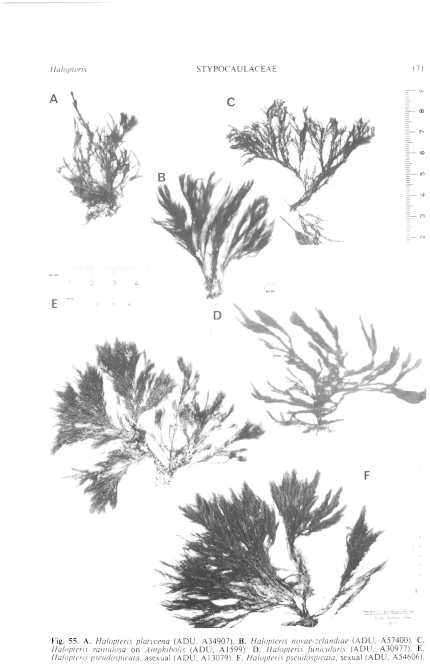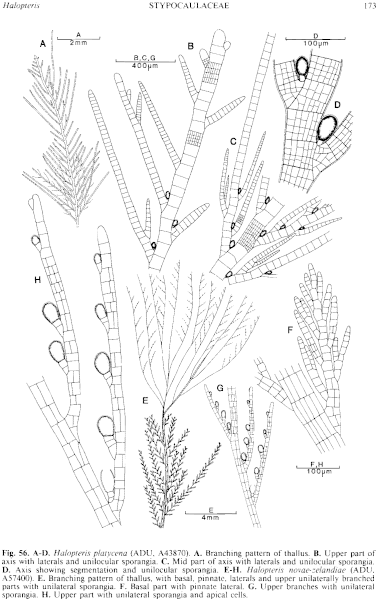|
|
|
|
|
|||||||||||
|
Electronic Flora of South Australia Species Fact Sheet
Phylum Phaeophyta – Order Sphacelariales – Family Stypocaulaceae
Selected citations: Lindauer et al. 1961: 164, fig. 19(1–4).
Reproduction: Unilocular sporangia (Fig. 56G,H) single, with a 1–3 (–8) celled pedicel, borne 3–8 cells apart in unilateral, adaxial series on tapering, unilateral, ramuli 25–40 µm in diameter, on the upper and mid axes; each sporangium becomes subtended by a short ramulus which develops further adaxial sporangia; sporangia ovoid, 40–70 µm long and 30–50 µm in diameter. Sexual reproduction unknown.
Type from Lyall Bay, New Zealand (Laing, Sept. 1894); in Herb. Sauvageau, PC.
Distribution: New Zealand, from Taranaki south.
In southern Australia, only known from Waterfall Bay, Tasman Pen., Tasmania, 13–19 m deep (McGeary-Brown, 29.x.1986; ADU, A57400).
Taxonomic notes: Mathis (Fig. 55B) medium brown, 3–7 cm long, densely tufted, with several erect axes from a compact rhizoidal holdfast 2–5 mm across; epilithic. Axes with distinct basal and upper parts; basal or juvenile axes (Fig. 56E, lower; F) pinnate or bipinnate, regularly alternately distichous every 1–2 segments, with relatively short, tapering, determinate laterals; corticating rhizoids present only near the base of axes; upper axes (Fig. 56E, upper; G) 2–6.5 cm long, slender, more or less distichous with simple or occasionally branched laterals many segments apart, but with short, distichous laterals when fertile (Fig. 56E, upper; G,H); phaeophycean hairs absent. Axes below 100–150 µm in diameter with segments L/B 0.3–0.8(- l), with a slight cortex only by subdivision of outer cells, above 40–65 µm in diameter with segments L/B 0.5–1.
This is the first record of H. novae-zelandiae from southern Australia, and as in New Zealand it is a deep water species. It is most closely related to the European II. filicina Kützing and to H. platycena, differing from the latter in the strong differentiation between basal and upper parts, the morphology of each, and the arrangement of the unilocular sporangia.
References:
LINDAUER, V.W., CHAPMAN, V.J. & AIKEN, M. (1961). The marine algae of New Zealand. II. Phaeophyceae. Nova Hedwigia 3, 129–350, Plates 57–97.
The Marine Benthic Flora of Southern Australia Part II complete list of references.
Publication:
Womersley, H.B.S. (14 December, 1987)
The Marine Benthic Flora of Southern Australia
Part II
©Board of the Botanic Gardens and State Herbarium, Government of South Australia
Illustrations in Womersley Part II, 1997: FIGS 55B, 56 E–H.

Figure 55 enlarge
Fig. 55. A. Halopteris platycena (ADU, A34907). B. Halopteris novae-zelandiae (ADU, A57400). C. Halopteris ramulosa on Amphibolis (ADU, A 1599). D. Halopteris funicularis (ADU, A30977). E. Halopteris pseudospicata, asexual (ADU, A13079). F. Halopteris pseudospicata, sexual (ADU, A54606).

Figure 56 enlarge
Fig. 56. A–D. Halopteris platycena (ADU, A43870). A. Branching pattern of thallus. B. Upper part of axis with laterals and unilocular sporangia. C. Mid part of axis with laterals and unilocular sporangia. D. Axis showing segmentation and unilocular sporangia. E–H. Halopteris novae-zelandiae (ADU, A57400). E. Branching pattern of thallus, with basal, pinnate, laterals and upper unilaterally branched parts with unilateral sporangia. F. Basal part with pinnate lateral. G. Upper branches with unilateral sporangia. H. Upper part with unilateral sporangia and apical cells.

|
Email Contact: State Herbarium of South Australia |

|